PISTOLS
L9A1 Browning HP
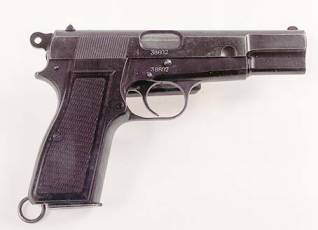
| Calibre: | 9mm | Muzzle Velocity: | 390m/s |
| Weight: | 0.99kg | Length: | 0.197m |
| Magazine Capacity: | 13 rounds | Rate of Fire: | 40 rounds/min |
| Effective Range: | 25m | Date in Service: | 1959 |
The L9A1, is the British designation for the military version of the post-1962 9mm Hi-Power, and is marked
'Pistol Automatic L9A1' on the left side of the slide. It started to replace Inglis variants in British service
from the late 1960ís, and the two types remained in service together until the Inglis variants were finally
retired in the late 1980ís. It is still in service with the UK military forces, although now fitted with
the more ergonomic Mk2 ambidextrous safety and grips. The L9A1 was also widely used by other Commonwealth
armed forces. The Hi-Power was the pistol issued to the British Special Air Service throughout the Cold War
era. Its usage was phased out in 2013 and replaced with the Glock 17.
Exploded Drawing Post 1961 L9A1
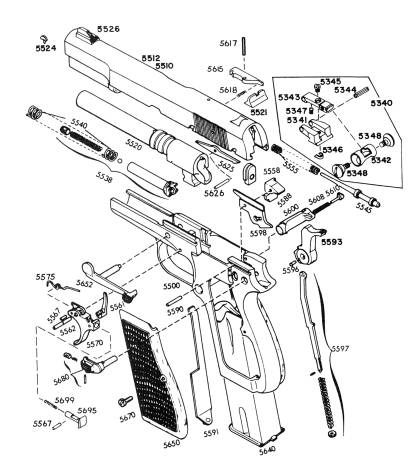
The High Power pistol, based on the 1935, Browning HP 35, GP 35 or Model 1935, is a recoil operated,
locked breech pistol. The trigger is single action, with external hammer. Original HP's featured frame mounted
safety at the left side of the frame, that locks both sear and slide. Modern versions,
also featured ambidextrous safety levers, that are also more comfortable to operate. Original HP's were
available with two sight wersions - with standard fixed sights, and with ajustable rear tangent sights ajustable
Grip panels were made from wood, and pistols were available with or without lanyard rings.
The HP was the first military pistol to have high capacity, staggered column magazine for 13 rounds plus one loaded
in the chamber. Newer Military versions, such as Mk.II and recent Mk.III featured more modern fixed combat sights
and polymer grip panels.
L105A1 Sig Sauer P226
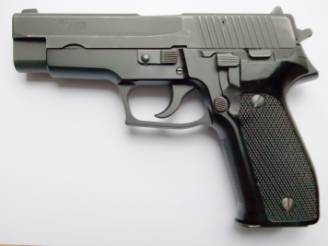
| Calibre: | 9mm | Muzzle Velocity: | 335m/s |
| Weight: | 0.964kg | Length: | 0.196m |
| Magazine Capacity: | 15 rounds | Rate of Fire: | 70 rounds/min |
| Effective Range: | 50m | Date in Service: | 2006 |
The British Army are currently using 3 SIG variants. The standard P226 designated L105A1 and improved version with corrosion resistant finish
designated L106A1, P229 a compact version of the P226, designated L117A2. It was an Urgent Operational Requirement (UOR), and is issued alongside the P229.
The P226 SIG Pistol (L105A1) is currently a limited issue sidearm, and was a significant contender in the competition to find a replacement for
the L9A1. Although it was well received by British Forces, the Glock 17 Gen 4, was adopted as the new British Army sidearm.
The SIG P229A2 (L117A2) The SIG P229A2 is a smaller variant of the P226, and is the replacement for the P228. It was a UOR, which is now being
issued in greater numbers, as it is more convenient to carry than the larger P226.
The P226, like the other members of the SIG Classic family, operates by the locked breech short-recoil method pioneered by John Browning.
On firing, the slide and barrel are locked together for a few millimetres of rearward movement, after which the barrel is cammed down at the rear.
By this time the bullet has left the barrel and the pressure has dropped to safe levels, whereupon the slide completes the rearward stroke, ejecting
the spent cartridge. The recoil spring then propels the slide forward, stripping a round from the magazine and in the last few millimeters of
forward movement the barrel is cammed upwards, locking the slide and barrel together again.
Exploded Drawing L105A1 Sig Sauer P226 MOD
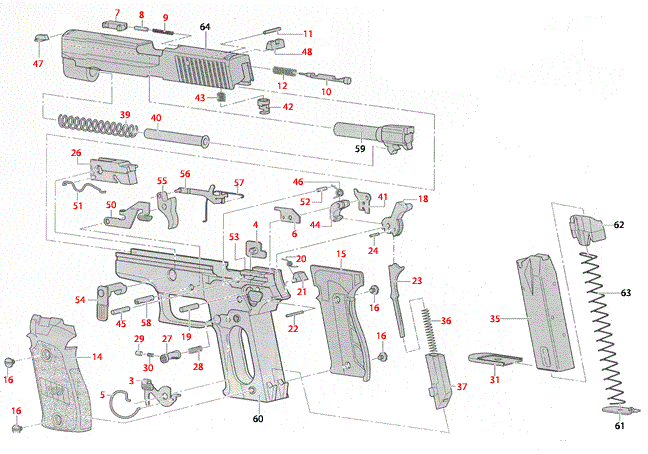
L113A1 Glock 17
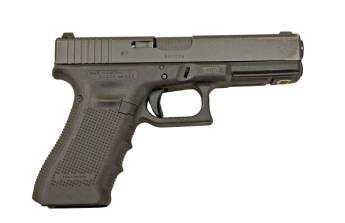
| Calibre: | 9mm | Muzzle Velocity: | 375m/s |
| Weight: | 0.625kg | Length: | 0.186m |
| Magazine Capacity: | 17 rounds | Rate of Fire: | 80 rounds/min |
| Effective Range: | 50m | Date in Service: | 2013 |
In early 2013, British armed forces received a new standard sidearm. The Glock 17 Gen 4 was brought into service, replacing the venerable Browning
L9 after over 40 years in the MoD inventory.
The Glock is a short-recoil locked breech semi-automatic pistol that fires via a striker-fired mechanism. Its frame, magazine body and other
components are made from high-strength nylon-based polymer. Versions of the Glock have been around since the early 1980ís.
The 4th generation version features a dual recoil spring assembly, which reduces felt recoil, enlarged, reversible magazine release catch
and a slightly smaller grip.
The Glock 17 Gen 4 is a modern weapon featuring several design elements that make it a marked improvement over the Browning it replaces:
∑ The Glock utilises a double-stack magazine which holds 17 rounds of 9x19mm Parabellum, compared to 13 held by the Browning's.
∑ The Glock's a frame is made from polymer material which means that a fully loaded Glock 17, despite its higher magazine capacity,
is still lighter than the Browning (905g vs 1000g).
∑ The Browning featured a manual safety release catch that increased the time taken to draw and fire the pistol.
The Glock features 3 independent internal safety mechanisms - trigger safety, drop safety and firing pin safety. This arrangement means that a
Glock with a round loaded in its chamber can be drawn and fired without further delay.
∑ Mil-standard rail that allows for the mounting of gun lights and laser pointers.
∑ Sights can be easily replaced e.g. swapped for night/low-light sights as needed.
Exploded Drawing L113A1 Glock 17 Gen 4 MOD
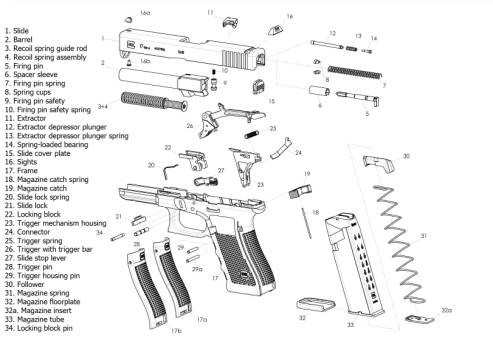
The MoD signed a £9m contract with the Viking Arms to provide the armed forces with more than 25,000 Glock 17 pistols and holsters.
The Glock 17 was delivered first to troops serving in Afghanistan in January 2013 before being rolled out throughout all arms of the services.
The pistol is carried as a secondary / backup weapon by frontline troops. In British service it is designated as the L131A1 General Service Pistol.